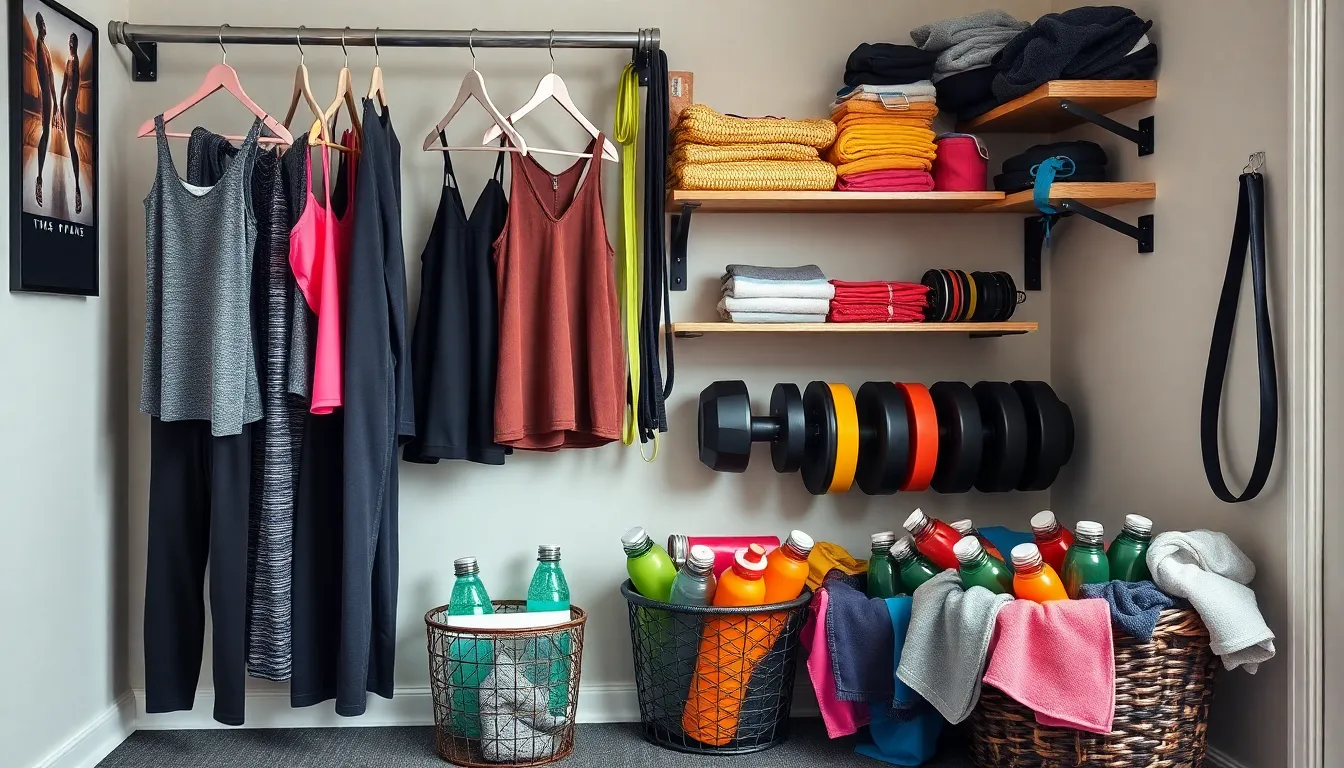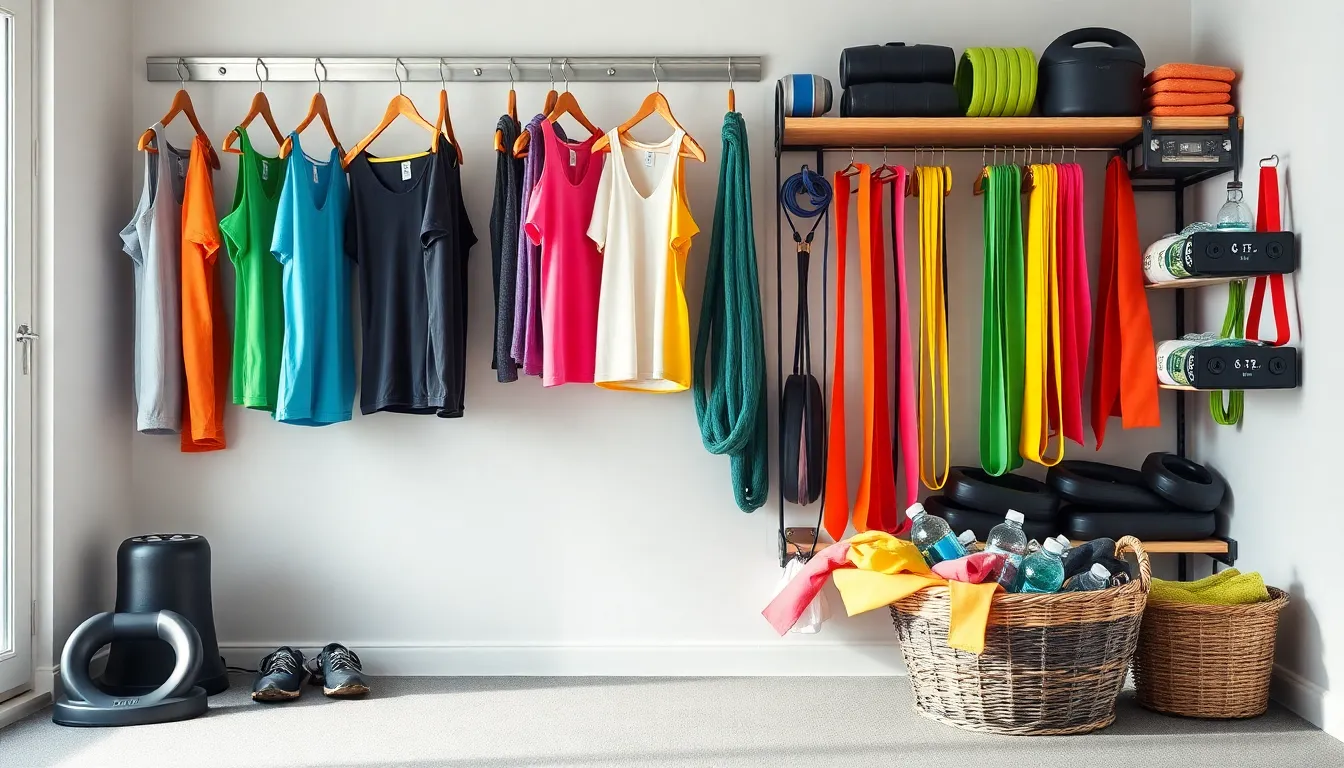Finding a pair of matching socks shouldn’t feel like a treasure hunt, yet here we are. When it comes to workout gear, chaos often reigns supreme. Between lost shoes, rogue resistance bands, and that elusive sports bra, getting ready for a sweat session can feel like a full-time job. But fear not! Organizing workout gear doesn’t have to be a Herculean task.
With a little strategy and a sprinkle of creativity, anyone can turn their fitness chaos into a streamlined sanctuary. Imagine breezing through your gear in record time, all while keeping your sanity intact. Let’s dive into some clever tips that’ll have your workout space looking sharp and your motivation soaring. Because who wouldn’t want to conquer their fitness goals in style?
Table of Contents
ToggleBenefits Of Organizing Workout Gear
Organizing workout gear offers several key advantages that enhance the fitness experience. Individuals gain access to their essentials quickly, leading to more effective workouts.
Improved Efficiency
Finding workout items becomes seamless. It reduces time spent searching for gear, maximizing workout quality. Organized spaces inspire individuals to maintain workout routines consistently. Setup becomes straightforward when gear is arranged by type, usage, or frequency. Consider placing frequently used items near the entrance. A designated area for shoes and clothes boosts readiness, allowing for spontaneous training sessions.
Reduced Stress
A clutter-free environment fosters greater mental clarity. Stress can diminish motivation, making it challenging to maintain a fitness regimen. By organizing gear, individuals create a welcoming space that encourages workouts. An orderly setup also minimizes frustration related to misplaced items. Knowing where everything is promotes a sense of control over workouts. This structure enhances confidence and boosts overall wellness, contributing to a more satisfying fitness journey.
Types Of Workout Gear To Organize


Organizing workout gear involves sorting a variety of items essential for fitness activities. Key categories include apparel, equipment, and accessories.
Apparel
Workout apparel includes items like leggings, shorts, tops, and sports bras. These clothing pieces should be grouped by type or frequency of use. Sorting them by category allows for easier access. Storing items in drawers or bins labeled for quick identification enhances efficiency. Utilize hangers or hooks for outerwear, keeping frequently used items visible. Keeping seasonal apparel in separate storage also helps maintain organization. Make sure to fold or roll clothing to maximize space and minimize wrinkles.
Equipment
Workout equipment encompasses weights, resistance bands, yoga mats, and more. Organizing equipment requires thoughtful placement based on size and usage frequency. Use shelves for larger items, while smaller pieces fit nicely in designated bins. Labeling storage areas helps individuals find what they need promptly. Position frequently used equipment at eye level. Consider wall-mounted racks for items like bikes or foam rollers, enhancing floor space. Maintaining clear pathways around equipment promotes safety and ease during workouts.
Accessories
Accessories include items such as water bottles, towels, headbands, and fitness trackers. Keeping these small items organized benefits overall workout efficiency. A designated basket or drawer for accessories streamlines access during workouts. Grouping accessories by type or activity type assists with quick retrieval. Storing water bottles in a refrigerator maintains hydration readiness. Hang towels on hooks for easy reach after a workout. Regularly inspecting these items ensures they remain clean and serviceable, promoting a consistent workout routine.
Tips For Organizing Workout Gear
Organizing workout gear enhances efficiency and makes exercise routines more enjoyable. Implementing simple strategies leads to a clutter-free workout space.
Declutter Your Space
Start by removing items that aren’t frequently used. Donate or discard workout apparel and equipment that no longer serves a purpose. Assess each item carefully to ensure it adds value to the fitness routine. After decluttering, assess remaining items for proper storage. Keeping only essentials simplifies access and reduces chaos.
Designate Storage Areas
Create specific zones for different types of gear. Assign a shelf for workout shoes, a drawer for apparel, and a rack for larger equipment. Clearly defined areas ensure quick access during workouts. Maintain consistency in storage for easy retrieval. Regularly review designated areas to adapt to changing workout habits and preferences.
Use Clear Containers
Opt for clear containers that allow visibility of contents. Label each container to distinguish between various items effectively. Organizing accessories such as resistance bands or yoga mats in transparent bins facilitates quick identification. Stackable options maximize vertical space while maintaining order. Clear containers provide ease of maintenance, ensuring a tidy workout environment.
Creative Organization Solutions
Effective organization boosts efficiency and enjoyment in workout routines. Several creative solutions exist to streamline storage of workout gear.
DIY Storage Ideas
Utilize everyday items to create functional storage. Repurpose old crates or wooden boxes as shelves for displaying shoes. Use tension rods to hang workout clothes in a closet, maximizing vertical space. Create a pegboard wall to showcase accessories like resistance bands and jump ropes, keeping them visible and accessible. Designate a small basket or bin for frequently used items to encourage quick grabs before workouts. Customize storage solutions to fit personal style while ensuring practicality.
Store-Bought Options
Explore various store-bought storage options that match personal needs. Look for multipurpose bins that stack to save space while keeping gear organized. Invest in clear containers with lids for visibility, aiding identification of items quickly. Consider a dedicated workout gear organizer that fits easily in closets or under beds. Shelving units designed for garage or utility spaces provide ample room for larger equipment. Purchasing a storage rack specifically for shoes enhances accessibility and neatness. Aim for products that combine aesthetics with functionality to encourage consistent use.


